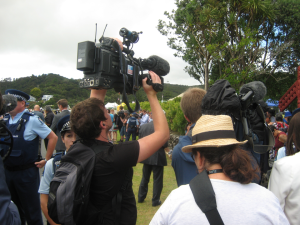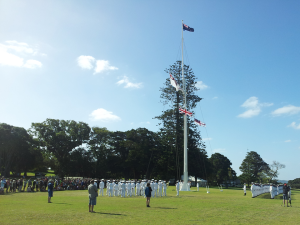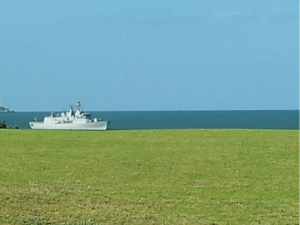I love it when Maori TV tries to ambush me and present me as a racist for demanding racial equality.
Each time they do this, we get a little more evidence that helps to convince honest, fair-minded Maori that their ignorant, one-eyed cousins are giving them a bad name.
Most helpfully, the radicals’ rants don’t just unsettle some of their own supporters and enrage all of ours. They also appal and convert lots of mild-mannered neutrals.
My live debate with Annette Sykes and the heckling partisan so-called ‘moderator’ Mihingarangi Forbes has opened a new front for us: a flurry of complaints to the Broadcasting Standards Authority.
One of these I’ll be posting shortly, a complaint about last Monday’s Native Affairs from a teacher.
But here now is a complaint about the previous week’s Native Affairs, from former newspaper sub-editor and author of the new book Tribes–Treaty–Money–Power, Mike Butler.
Mike is also preparing a complaint about last week’s show, but first things first.
It would be most helpful, dear readers, if you would each consider lodging your own complaint about each of the last two programmes.
Bureaucrats respond to numbers, and this state-funded racist channel needs to get the message that there is a difference between criticism and racism, and that they can’t get away with unfairly smearing people like Allan Titford, Martin Doutre and me.
Tying them up replying to numerous complaints, and having to provide redress for their bias, should help them in their quest to understand the meaning of balance. 🙂
_________________
Native Affairs BSA complaint
Date: May 26, 2014
To: Paora Maxwell,
Chief Executive,
Maori TV
PO Box 113-017
Newmarket
Auckland 1149
Attn Vienna.Richards@maoritelevision.com
From: Mike Butler,
[address]
[phone number]
[email address]
Re: Broadcasting Standards Authority complaint about What lies beneath
The Native Affairs item titled What lies beneath that aired on Monday, May 12, 2014, revisited the long story of Northland farmer Allan Titford who bought land at Maunganui Bluff in 1986 for $600,000 and was subjected to a squatter protest from 1987 during a Waitangi Tribunal claim for part of his land.
Titford had no interest in treaty claim matters until a group of bullying hostile protesters occupied his land and wrecked his business.
The occupation, that included two house fires, verbal abuse, stock thefts, intimidation, vandalism, trespass, cutting fences so that stock would wander, shooting stock, sabotaging Titford’s bulldozer, threatening with a gun, assault, looting, stalled a subdivision project and meant he could not refinance or repay a two-year mortgage.
Eventually, Titford sold the farm to the government for $3.225-million in 1995. Little was heard of the issue until last year when a matrimonial dispute resulted in Titford being jailed for 24 years.
One count he was found guilty of was for burning down his house.
What lies beneath is built around an interview with Alex Nathan of Te Roroa.
In the intro, presenter Mihingarangi Forbes set the scene by saying when Titford “accused the Northland iwi, Te Roroa of being greedy Maori who were after his land”, the country rallied behind him.
Te Roroa, he said, were violent terrorists who burned down his home”.
She went on to say: “Fourteen years later the truth came out – it was Allan Titford who burnt his house down – but some media and lobby groups continue to support him”.
Reporter Iulia Leilua’s 20-minute two-part feature could leave an open-minded viewer thinking that Titford was finally exposed as evil, that Te Roroa claimants were wronged innocents, and that there exists a shadowy but well-funded very right wing conspiracy out to deny Maori of rights.
This complaint shows that What lies beneath was a biased and inaccurate presentation of the Maunganui Bluff land claim issue, that included unfair treatment of protagonist Allan Titford, along with racist and derogatory treatment of his supporters.
The feature breached standards four, five, six, and seven of the broadcasting code.
1. Failed to present significant viewpoints on controversial issues
The Broadcasting Standards Authority is quite clear under Standard 4 – Controversial Issues – Viewpoints that when discussing controversial issues of public importance in news, current affairs or factual programmes, broadcasters should make reasonable efforts, or give reasonable opportunities, to present significant points of view, either in the same programme or in other programmes within the period of current interest.
a) Guideline 4a says significant viewpoints should be presented fairly in the context of the programme.
What lies beneath presented in the intro what Maori TV presenters considered was the mainstream view 22 years ago, after July 4, 1992, when the Titford house burned to the ground.
That view was that Northland iwi Te Roroa were “greedy Maori who were after his land”, who were also “violent terrorists who burned down his home”.
What lies beneath also outlined in the intro the current viewpoint of Maori TV presenters, that “14 years later the truth came out – it was Allan Titford who burnt his house down – but some media and lobby groups continue to support him”.
Two opposing viewpoints were presented in What lies beneath but Maori TV presented the viewpoint it disagreed with in a hostile, pejorative manner, meaning that the viewpoint was not presented fairly.
b) A further assessment of whether a reasonable range of views has been presented is described in guideline 4b, which asks whether the programme approaches a topic from a particular perspective.
Maori TV claims to design its programming to deliver a Maori perspective.
It appears that presenters believe that by presenting What lies beneath from the viewpoint of Te Roroa, with Titford being non-Maori they would fulfil the “Maori perspective” role of Maori TV.
However, ifLeilua had asked a few more questions, listened, and looked further, she would have quickly found that Titford’s now estranged wife has Ngapuhi ancestry, and that Ngapuhi leader the late Graham Rankin appealed to the Minister of Treaty Negotiations, Margaret Wilson, to help the Titford family.
Rankin’s view was that the Titfords had been unlawfully dispossessed of their farm at Maunganui Bluff, Northland. [1]
For Maori TV to argue that equating the Te Roroa claim with a Maori perspective fails to understand that part of the dispute over land at Maunganui Bluff was a clash between Te Roroa and Ngapuhi.
As a result of the Battle of Te Ikaranganui in 1825 Ngapuhi dominance over the area was achieved.
Te Roroa were allowed to stay in the area under the protection of Parore Te Awha of Ngapuhi, whose name was on the Maunganui block sale deed.
Tiopira Kinaki, the other vendor named on the 1876 sale deed, was Te Roroa.
The Titford farm and the area on it claimed by Te Roroa were included in the 1876 Maunganui block sale. [2]
2. Failed to be accurate on all points of fact
The Broadcasting Standards Authority is also clear, under Standard 5 Accuracy, that broadcasters should make reasonable efforts to ensure that news, current affairs and factual programming is (1) accurate on all points of fact, and/or (2) does not mislead.
a) Forbes in the intro incorrectly said: “fourteen years later the truth came out – it was Allan Titford who burnt his house down”.
In fact the house fire occurred on July 4, 1992, which was 22 years ago, not 14 years as Forbes said.
But more importantly, Titford was found guilty of burning his house, an allegation he continues to deny, and a conviction he plans to appeal or seek a retrial on.
Therefore, the truth or falsity of the statement “Allan Titford … burnt his house down” remains unknown except to the perpetrator.
Moreover, viewers were not made aware of the existence of two sworn statements that cast reasonable doubt on Titford’s guilt regarding the arson.
Reporter Leilua was given copies of these affidavits and had all details explained to her, but there was no reference to this in the final edit.
These affidavits existed at the time of Titford’s trial, but were not introduced as evidence.
Ansell recorded footage of the actual interviews because earlier biased treatment at the hands of Maori TV prompted him to take a cameraman along, something that reporter Leilua strenuously objected to. [3]
b) Reporter Leilua said: “By 1876 nearly 90,000 acres of Te Roroa land had been bought by the Crown. However, Te Roroa disputed the inclusion of urupa, reserves, and the lake in the sale arguing that there had been a mistake in the survey”.
The land area quoted by Leilua was incorrect. The Maunganui block upon which the Titford farm was located, was 37,592 acres and the Waipoua block 35,300 acres giving a total of 72,892 acres, which is more than 17,000 acres short of Leilua’s sweeping guess.
Leilua was incorrect to characterize that land as solely belonging to Te Roroa. The Maunganui block was awarded to both Tiopira Kinaki of Te Roroa and Parore Te Awha of Ngapuhi.
Leilua was incorrect to imply Te Roroa at the time disputed the inclusion of urupa, reserves, and the lake. The only dispute at the time of the sale was the Alleged Improper Sale Inquiry 1876 prompted by Tiopira Kinaki when he discovered that Parore Te Awha received an extra £500.
This was nothing to do with what was included in the sale.
Leilua failed to say that the first appearance of a claim for that land, known as Manuwhetai, and another area on a neighbouring farm known as Whangaiariki, was in 1899, after both vendors and all involved in the 1876 sale had died.
Neither did she say that the claim was rejected at that time.
Leilua did not mention a special sitting of the Native Land Court investigating a claim for Manuwhetai and Whangaiariki held in Kaihu in 1939.
Neither did she mention a recommendation by Chief Judge G.P. Shepherd to parliament 1942 that:
- The only reserve in the Maunganui block provided for in the 1876 sale was a 250-acre eel fishery reserve known as Taharoa for vendor Parore Te Awha;
- Manuwhetai and Whangaiariki were not mentioned in the deed of sale;
- Neither were they mentioned in the inquiry into the sale held in 1876;
- The sale deed had a certificate to show that vendors Parore Te Awha and Tiopira Kinaki understood the terms of the sale;
- The deed had a certificate to show no fraud had taken place;
- A memo dated February 12, 1876, confirmed that Parore got Taharoa. [4]
Leilua did not say that nothing further was heard of this claim until 1987, after the Waitangi Tribunal was empowered to investigate claims all the way back to 1840, and when Titford began advertising sections in his coastal subdivision.
Leilua did not look into the evidence Te Roroa cited to support their view that Manuwhetai and Whangaiariki were left out of the sale because of a mistake in a survey.
Te Roroa claimants cited Plan 3297/8 as “proof” that Manuwhetai and Whangaiariki had been taken in error by the Crown.
Apparently unaware of Te Roroa reasoning for their claim, Leilua did not look into facts around that purported evidence.
Titford found that Plan 3297/8 was created by surveyors Barnard and Stephens for a landowner named Wi Pou, of the Ngaitu hapu, as part of a proposal to buy from the government two reserves on the south side of Maunganui Bluff.
Those reserves were to be named Manuwhetai and Whangaiariki.
Plan 3297/8 remained in government files as a record of a proposal that did not proceed.
c) Leilua said: “Under a National government in 1995, after rejecting numerous offers, Allan Titford finally sold his land to the Crown for five times more than he paid”.
While it is true that the sale price of $3.225-million is about 5.3 times the purchase price, Leilua did not say that the $3.225-million included 1450 head of stock valued at $750,000 and plant at $50,000.
Neither did she say that out of the $3.225-million, $1.8 million went to the National Bank and $425,000 went to other creditors.
Therefore, Titford was left with $200,000 for land he paid $600,000 for nine years earlier
Leilua collected a comment from academic Ranginui Walker who alleged Titford made “a huge profit”. Far from “a huge profit”, Titford came out $400,000 behind after working nine years for nothing and facing bullying from claimants, inaction by police, and stonewalling by the government.
d) Guideline 5c says news must be impartial.
The selection of sources for What lies beneath, and the extra time allowed to those supporting the theme of the feature, was far from impartial. Bias appeared in the number and frequency of comments for either Titford or Te Roroa.
For Titford, Ansell was the sole representative and featured in a single, highly selective interview. Doutré, who has supported Titford elsewhere, spoke entirely about evidence for Celtic New Zealand. Former MP Ross Meurant spoke for Titford in old footage. Newman’s single comment was neither about Titford nor Te Roroa.
For Te Roroa, claimant Alex Nathan spoke six times, Taua spoke four times, Ranginui Walker spoke twice, and Moon spoke once.
3. Failed to be fair
The Broadcasting Standards Authority is also clear, under Standard 6 – Fairness, that broadcasters should deal fairly with any person or organisation taking part or referred to.
The word “fair” means “treating people equally without favouritism or discrimination”.
For the purpose of guideline 6a, What lies beneath was aired on a current affairs programme, a genre that is expected to be factual.
The feature breached Standard 6 – Fairness in two ways:
a) Fair coverage of the Titford/Te Roroa saga would present known facts on both sides of the dispute.
Instead, after jumping to the conclusion that Titford did burn down his house, reporter Leilua recorded Nathan saying: “We knew that we were right”, and subsequent comments were collected to support this view.
Evidence that raised reasonable doubt as to whether Titford started the fire, such as two sworn statements indicating another party had admitted responsibility, was ignored.
This stacking of comments to support the pre-conceived view of both the reporter and the presenter breaches standard 6, guideline 6a, which requires fairness in a factual programme.
b) Apparently assuming that Titford burnt his house down and blamed Te Roroa, when reporter Leilua was given two sworn statements creating a reasonable doubt as to the accuracy of that assumption, Leilua ignored the affidavits and edited out of the final cut any reference to them by interviewee John Ansell.
This breaches standard 6, guideline 6b, which requires broadcasters to exercise care in editing programme material to ensure that the extracts used are not a distortion of the overall views expressed. [5]
4. Encouraged discrimination and denigration
Under Standard 7 – Discrimination and Denigration, broadcasters should not encourage discrimination against, or denigration of, any section of the community on account of sex, sexual orientation, race, age, disability, occupational status, or as a consequence of legitimate expression of religion, culture or political belief.
The word “discrimination” refers to making “an unjust or prejudicial distinction in the treatment of different categories of people, especially on the grounds of race, sex, or age”.
The word “denigration” means casting “aspersions on, decry, criticize unfairly, attack, speak ill of, speak badly of, blacken the character of, blacken the name of, give someone a bad name, sully the reputation of, or spread lies about”.
What lies beneath breaches Standard 7 because it encourages discrimination against and seeks to denigrate those who criticize the divisiveness of race-based affirmative action and treaty politics.
An encouragement to discriminate against those who criticise treaty politics and race-based affirmative action appeared in the intro to Part 2 of What lies beneath, when presenter Mihingarangi Forbes described Titford supporters as “people who were anti-treaty and anti-Maori, many of whom used their money, time, and connections to push their political agendas”.
The only evidence of support by wealthy individuals of critics of treatyism was an assertion that “rich-lister Alan Gibbs” backed the New Zealand Centre for Political Research that pushes against race-based special treatment.
The feature was silent on the existence of the network of multi-millionaire neo-tribal groups known as the Iwi Leaders Group that pushes for race-based special treatment.
Denigration of those who criticise treaty politics and race-based affirmative action appeared in the title What lies beneath, which captured an implication of a sinister pervasive racist undercurrent, with those drawing attention to the divisiveness of treaty politics castigated as racist.
Smearing a person with the allegation that he or she is racist appears intended to silence debate because it is based on the assumption that no right-minded person would want to speak out for fear of being called a racist.
The denigration of critics of treatyism as racist is in itself racist.
Remedy sought
Native Affairs staff members have shown an ability to investigate complex stories while asking hard questions. So why did they not do so in this 20-minute two-part feature that aired on Monday, May 12?
Errors in this feature may be remedied by a 20-minute clip on Native Affairs that includes:
1. An interview with someone who knows the details of the impact of the occupation at Maunganui Bluff on the Titfords, and the background of the Te Roroa claim for Manuwhetai and Whangaiariki.
2. An interview with Alex Nathan that asks:
a) Is it not true that on August 7, 1987, squatters moved on to the beach part of the section in force and erected signs to frighten away any prospective buyers.
b) Is it not true that on August 16, 1987, Hughie Te Rore and Huia White told Titford that if he gave them the land they would drop their tribunal claim.
c) Is it not true that on December 5, 1987, at 1.15pm, Hughie Te Rore and Huia White arrived at the house and said that if Titford removed the buildings used by squatters they would take revenge within 24 hours and it would be nationwide news.
d) Is it not true that on January 12, 1988, a group of claimants in a green Toyota Corona shot stock in Titford’s paddock. Claimants also arranged for the Historic Places Trust to come in and make the site a sacred area.
e) Is it not true that on January 20, 1988, claimants erected a large carved pole on Titford’s land, an event that local councillors, local non-Maori, Maori Marsden, and TVNZ reporters attended.
f) Is it not true that on March 22, 1988, claimant Hugh Te Rore had Conservation Department archaeologist Leigh Johnson (Mr) visit Titford’s farm. Johnson told Titford he had permission to be there from landowner Hugh Te Rore. Johnson also told Titford that the area was from then on wahi tapu and a reserve.
3. An interview with Ranginui Walker that asks:
a) Is it not true that the $3.225-million the government paid for the Titford farm included 1450 head of stock valued at $750,000 and plant at $50,000?
b) Is it not true that out of the $3.225-million purchase price, $1.8 million went to the National Bank and $425,000 went to other creditors?
c) Is it not true that Titford was left with $200,000 for land he paid $600,000 for nine years earlier?
d) Do you still stand by your comments that Titford made “a huge profit” out of the sale of his farm?
4. An interview with historian Paul Moon that asks:
a) Is it not true that as an historian, past events and old documents are your stock in trade?
b) Therefore, based on your expertise in past events and old documents, is it not true that the only reserve in the Maunganui block provided for in the 1876 sale was a 250-acre eel fishery reserve known as Taharoa for vendor Parore Te Awha?
c) Is it not true that Manuwhetai and Whangaiariki were not mentioned in the 1876 deed of sale?
d) Is it not true that neither were mentioned in the inquiry into the sale held in 1876?
e) Is it not true that the sale deed had a certificate to show that vendors Parore Te Awha and Tiopira Kinaki understood the terms of the sale?
f) Is it not true that the deed had a certificate to show no fraud had taken place?
g) Is it not true that a memo dated February 12, 1876, confirmed that Parore got Taharoa?
h) Is it not true that the first appearance of a claim for land known as Manuwhetai and Whangaiariki was in 1899, after both vendors and all involved in the 1876 sale had died?
i) Is it not true that Plan 3297/8 was created by surveyors Barnard and Stephens for a landowner named Wi Pou, of the Ngaitu hapu, as part of a proposal to buy from the government two reserves on the south side of Maunganui Bluff. Those reserves were to be named Manuwhetai and Whangaiariki?
j) Is it not true that Plan 3297/8 remained in government files as a record of a proposal that did not proceed?
___________________________
[1] Graham Rankin, Letter, June 4, 2001. http://www.treatyofwaitangi.net.nz/AllanandSusanvsTheWaitangiTribunal.html
[2] The Sale of Maunganui-Waipoua, The Te Roroa Report 1992. http://www.waitangi-tribunal.govt.nz/reports/viewchapter.asp?reportID=7df6e15e-2c4d-4dd0-9e60-50a88ffb48a9&chapter=13
[3] See John Ansell’s recorded footage of the actual interviews see https://treatygate.wordpress.com/2014/05/13/what-maori-tv-didnt-show-you/#comments
[4] Native Purposes Act 1938. http://atojs.natlib.govt.nz/cgi-bin/atojs?a=d&d=AJHR1942-I.2.1.8.4&e=——-10–1——0–
[5] See John Ansell’s recorded footage of the actual interviews see https://treatygate.wordpress.com/2014/05/13/what-maori-tv-didnt-show-you/#comments































